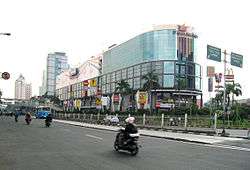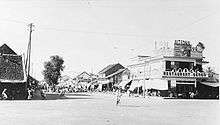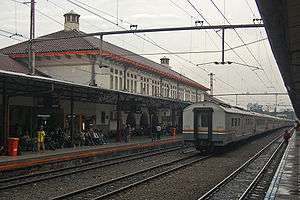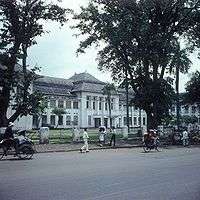Senen
| Senen Subdistrict Kecamatan Senen | |
|---|---|
| Subdistrict | |
 Plaza Atrium Senen in the Administrative Village of Senen, where the name Senen came from. | |
| Country | Indonesia |
| Province | Special Capital City District of Jakarta |
| City | Central Jakarta |
| Area | |
| • Total | 4.23 km2 (1.63 sq mi) |
| Postal code | 104XX |
Senen is a commercial center in Jakarta, Indonesia. The area was developed in the 18th-century as Pasar Senen at the time when governor Daendels established the bovenstad ("the uppertown") as the new center of government of Batavia. The area is one of the oldest commercial center in Jakarta.[1] This historic commercial center of Senen is located in what is now the Administrative Village of Senen, in the northern part of the Senen Subdistrict. This article covers both Senen as the historic commercial center and as a Subdistrict of Central Jakarta.
Toponym
The name Senen was derived from Pasar Senen, "Monday Market".
Government
As a Subdistrict, the boundaries of Senen are a railway line to the east and Ciliwung River to the west, Jalan Pramuka Street to the south, and Jalan Abdul Rahman Saleh-Kwini II-Senen Raya IV marking the northern boundary. The area is served with Pasar Senen railway station and Senen bus terminal which is served by both Transjakarta and Kopaja bus services. Some of the important roads of the area are Kramat Raya Road (the main road that formerly linked Jakarta with Jatinegara) and Senen Raya Street (the focal point of the Senen market).
The subdistrict of Senen is divided into six administrative villages (kelurahan):
- The location of the Kwitang book market.
- Kenari – area code 10430
- The southernmost area of Senen Subdistrict and the location of the University of Indonesia and Cipto Mangunkusumo Hospital.
History

This section covers the history of Senen with a focus more on the Pasar Senen area.
Early establishment of Pasar Senen
Following the establishment of the upper town (bovenstad) of Batavia, Justinus Vinck, a Dutch entrepreneur, decided to develop two markets to serve the upper town. On August 30, 1733, Vinck established two markets: Pasar Tanah Abang (erroneously spelled as Tanabang) to the southwest of Koningsplein and Pasar Senen (variously spelled as Pasar Senin, Bazaar Senin, Passar Senen, Passer Senen) to the east of Koningsplein. Pasar Senen was located on the eastern edge of Weltevreden, a European-centric neighborhood of the upper town.[1] Both markets were connected with a road simply known as weg van Tanabang naar Weltevreden, which would later become the Kwitang and KH. Wahid Hasyim street. The exact area of Pasar Senen was centered in what is now Segitiga Senen (Indonesian "Senen Triangle") and Pasar Senen (present government market between the railway station and Senen street).
In the beginning of the 19th-century, Pasar Senen became the focal point of Weltevreden, being strategically located at the military heart of Weltevreden, the Kampementen - and at the junction of the road which connects Batavia to Meester Cornelis (this road would later become Matramanweg, and then Kramat Raya - Salemba Raya street). Settlements also prospered along this road, such as Kampung Kwitang, Kampung Kramat and Kampung Salemba or Slemba. Several forts and military complex were established to keep the security of the road.
Pasar Senen also became the gateway of Batavia for people coming from the kampung on the east of Batavia.[2]
Modern colonialism
In the following course of the history, Pasar Senen grew as a mainly Chinese commercial center. Pasar Senen is filled with Chinese-style shop houses and known for its narrow alleyways (Dutch gang). Among the alleyways were Gang Wang Seng, Gang Kenanga Noord, Gang Kenanga Zuid in what is now the Segitiga Senen area; and Gang Senen Binnen in what is now the Pasar Senen area.[3][4]
The road connecting Pasar Senen with Meester Cornelis thrived as well. Then known as Matramanweg, some institutions were established with its frontal facade facing the road and making use of the Ciliwung river view for its rear facade. Among this institutions were the STOVIA, an opium factory, and a military complex.
In the late 19th-century, Pasar Senen was traversed with railway and tramlines. In 1886, a railway station was established to the east of Pasar Senen, serving as logistic station for the area. Newer station was built a few yards to the east of the older station in 1925. With railway station and tramway traversing the area, Pasar Senen became Jakarta's busiest commercial and entertainment center.
The beginning of 20th century saw several theatres established around Pasar Senen area, e.g. the Rex Cinema and Grand Theater Cinema.
Post-independence period

Following the independence of Indonesia, people from around Indonesia began to flock to the new capital of the country in search for possibilities not available in their regional homelands.[5] Pasar Senen area, originally a Chinese-dominated area, became populated by Bantenese, West Javanese, Padang and Batak traders during the 1950s.[3]
By the late 1950s, Pasar Senen had deteriorated into a slum and home to criminal gangs, illegal gambling, prostitutes, and pickpockets. This reputation continues to this day despite the multiple revitalization of the area.[6] During the period, the area of Senen - especially those adjacent to Pasar Senen railway station - became Jakarta's largest red light district.[1] Economically and socially marginalized people would hung out in Planet Senen, such as the homeless, market sellers, contract laborers, prostitutes, criminals, gamblers, and artists. The red light district area received the nickname "Planet Senen", a catchy 1960s term alluding to the Space Race between the Soviet Union and the United States, to refer its relative isolation from the rest of Jakarta.[7] Planet Senen was quoted as "a black place (daerah hitam), a place without a master/without rules, with dead bodies on the side of the road.[8] A form of prostitution appeared in Planet Senen, known as doger dancer (penari doger). Doger dancer are performed by women wearing a very tight and very thin kebaya dress and a batik cloth. They also wear locally made lipstick and powder for their make up; because during that time, imported cosmetic product was not available. These dancers are mostly immigrants from the east of Jakarta e.g. Klender and Bekasi. Doger dance performance started in the evening, where men are allowed to touch and kiss the dancers for a sum of money. This form of prostitution oven occurred inside the railway carriage in the Pasar Senen railway area.[9]
Planet Senen also became a popular meeting place for young artists, poets, and writers in the 1950s-1960s.[1] These people are known as the Seniman Senen (Senen Artist), would congregate in locals to discuss philosophies and aesthetics of Jakarta.[5] Among the seniman senen were Sukarno M. Noor, Rendra Karno, Dahlia, Nurnaningsih, A.N. Alcaff, Benyamin Sueb, Bing Slamet, and Misbach Yusa Biran.[10] The melting pot of artists in Planet Senen would gave birth to Jakarta's recording stars of the 1970s and 1980s.
Dangdut, a genre of Indonesian urban music, developed in marginalized urban neighborhoods in the late 1960s and early 1970s such as Bangunrejo in Surabaya, Sunan Kuning in Semarang, and Planet Senen in Jakarta. Dangdut musicians who started their career in Planet Senen were Asmin Cayder, Rhoma Irama, Mukhsin Alatas, Husein Bawafie, and Mashabi.[11]
Project Senen (1960s)

In 1962, the Jakarta city government and several private investors formed PT. Pembangunan Jaya as a joint public-private partnership to revitalize Senen and replaced the old shops. The strategy, known as the Proyek Senen ("Project Senen") replaced the old Chinese shops with a complex of modern shopping center, consisting of six modern market blocks numbered I to VI. This plan displaced many urban dwellers from the original Planet Senen. Construction of Block I started in 1962 and was completed in 1966. The last Block VI was completed in 1977. A new bus terminal was built adjacent to Block VI in 1980.[1][12]
In 1973, as part of the revitalization strategy of Pasar Senen, the Planet Senen prostitution and gambling complex were shut down.[1] Senen prostitutes were displaced to Kramat Tunggak, North Jakarta, by governor Ali Sadikin, which would also become the largest red light district in later years. In 1968, Taman Ismail Marzuki arts center on nearby Cikini were established as a new congregation point for Senen artists and poets.[5]
On 15 January 1974, students from the Planet Senen youth center demonstrated against the government’s policy regarding the role of foreign investment in Indonesia. Beginning in front of Senen market, the demonstration led to a series of riots known as the Malari incident. The riots attacked a visible Japanese presence in Indonesia such as an Astra dealership selling Toyota-brand cars on Sudirman Street. Later the riots shifted to an anti-Chinese Indonesian pogrom, attacking stores owned by ethnic Chinese, including the Senen shopping complex.
Present time
In 1990, the government built a modern shopping center, the Atrium which before 1997 Asian financial crisis hosted the international brand of Yaohan and Marks & Spencer as its anchor tenant.
With the trend of transit-oriented development in Jakarta ushered by construction of infrastructure projects such as the Jakarta Mass Rapid Transit, Senen will be subjected to a new urban design scheme which integrates the existing infrastructure Pasar Senen railway station, the TransJakarta bus rapid transit, and the future Jakarta Mass Rapid Transit station for the east-west line.
Landmarks of Senen Subdistrict

The following historic landmarks and important places are located within Senen Subdistrict: Within the historic Senen
- Gelanggang Remaja Senen
- Grand Theater cinema
- Pasar Senen Station
- Senen Shopping Centre (consists of Pasar Senen ("Senen market") and Plaza Atrium Senen)
Within the Subdistrict of Senen
- Cipto Mangunkusumo Central Hospital
- Faculty of Medicine of the University of Indonesia
- Museum of Indonesian National Awakening (formerly the STOVIA medical school)
- National Library of Indonesia
- St. Carolus Hospital, Paseban administrative village
- Sumpah Pemuda Museum
- Vincentius orphanage (circa 1855)
- The Wayang Orang Bharata theatre which stages Wayang orang shows on most Saturday nights
Grand Theater cinema
The Grand Theater is a cinema located in Jakarta, Indonesia. Despite its poor condition, the cinema is Jakarta's oldest cinema that is still in operation. The historic cinema dates back to the 1930s when it was called Rex Cinema and was centrally located in Batavia's trade and entertainment district Senen. Despite its history, the cinema is now in an extremely poor condition and survived by offering low budget movies (usually horror or erotic).[13]
Grand Theater dates back to the 1930 when it was called the Kramat Theatre. The cinema was prominent as it was centrally located in Weltevreden's entertainment district, Senen. In 1935, Kramat Theatre was renamed Rex Theatre. In November 1946, the cinema received the name November 1946 after a total renovation. The cinema's golden age was during the 1930s up until the 1950s, an era in Jakarta before television was available.[13]
When television is available in Indonesia, many cinemas are closed in Jakarta, including Jakarta's oldest cinema, the Globe, which was opened in 1910 but has to be closed in 2009. Grand Theater on the other hand survived by offering low budget movies e.g. horror and erotic movies. With the closing of the Globe, Grand Theater is currently the Jakarta's oldest cinema that is still in operation.[13]
Patung Perjuangan Senen
Patung Perjuangan Senen ("Senen Monument of Struggle") is a monument located within the complex of Gelanggang Remaja Senen (Senen Youth Center). The monument was officially inaugurated by the mayor of Central Jakarta A. Munir on May 2, 1982. It was erected to commemorate the revolutionary struggle in maintaining the self-proclaimed independence of Indonesia from the Allied occupation, specifically the arrival of the war ship of the Allied in Jakarta Bay on September 29, 1945.[14]
The monument was designed by native sculptor Sadiman, Suhartono and Haryang Iskandar, and painter Suyono Palal. It is made with cement concrete cast from Sleman Regency, Central Java.[14]
Future development
Senen railway station will be developed in the future as an integrated transit-oriented planning.
See also
| Wikimedia Commons has media related to Senen. |
References
- 1 2 3 4 5 6 Merrillees 2015, p. 136.
- ↑ Oehler, Kaart van de Ommelanden van Batavia 1825.
- 1 2 Merrillees 2015, p. 55.
- ↑ Top. Bureau, Kaart van Batavia en Omstreken 1897.
- 1 2 3 Winet 2010, p. 69.
- ↑ Merrillees 2015, p. 4.
- ↑ Shahab 2006, p. 162.
- ↑ Weintraub 2010, pp. 84-5.
- ↑ Shahab 2006, p. 163.
- ↑ Yayasan Abipraya Komunika & Yayasan Mitra Sembilan Enam 1997, p. 94.
- ↑ Weintraub 2010, p. 85.
- ↑ http://www.arsitekturindis.com/?p=257
- 1 2 3 Merrillees 2015, p. 87.
- 1 2 "Perjuangan Senen, Monumen". Ensiklopedi Jakarta. Jakarta: Dinas Komunikasi, Informatika dan Kehumasan Pemprov DKI Jakarta. 2010. Archived from the original on September 5, 2014. Retrieved September 25, 2016.
Cited works
- de Vletter, M.E.; Voskuil, R.P.G.A.; van Diessen, J.R. (May 1997). Batavia/Djakarta/Jakarta Beeld van een metamorfose. Purmerend: Asia Maior. ISBN 9074861091.
- Merrillees, Scott (2015). Jakarta: Portraits of a Capital 1950-1980. Jakarta: Equinox Publishing. ISBN 9786028397308.
- Kaart van Batavia en Omstreken [Map of Batavia and Surrounding] (Map) (Batavia ed.). 1:20000 (in Dutch). Cartography by Topografische Bureau. 1897. Retrieved February 14, 2016.
- Kaart van de Ommelanden van Batavia [Map of the Surrounding of Batavia] (Map) (Batavia ed.). 1:15000 (in Dutch). Cartography by C. Oehler. 1825. Retrieved February 14, 2016.
- Shahab, Alwi (2006). Cerita Cerita Betawi - Maria van Engels: menantu Habib Kwitang [Betawi Stories - Maria van Engels: Daughter in Law of Habib Kwitang]. Jakarta: Republika. ISBN 9789793210728. Retrieved September 29, 2016.
- Weintraub, Andrew Noah (2010). Dangdut Stories: A Social and Musical History of Indonesia's Most Popular Music. New York City: Oxford University Press. ISBN 9780199780235.
- Winet, Evan Darwin (2010). Indonesian Postcolonial Theatre: Spectral Genealogies and Absent Faces. Hampshire: Springer. ISBN 9780230246676.
- Yayasan Abipraya Komunika & Yayasan Mitra Sembilan Enam (1997). Tracing the Path of Discovery. Jakarta: Gedung Kesenian Jakarta. ISBN 9789799527004.